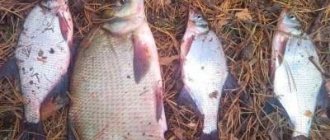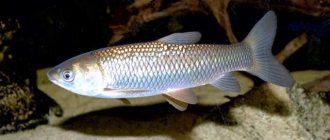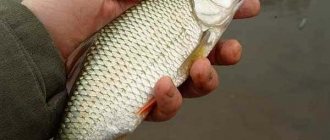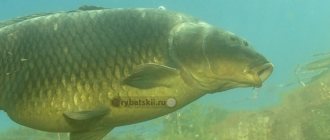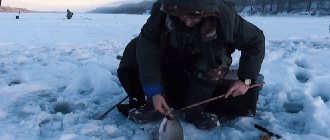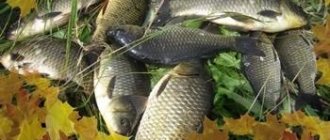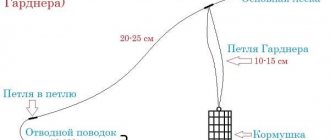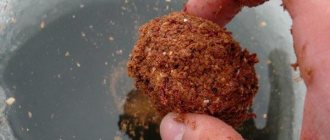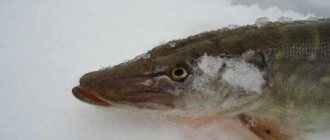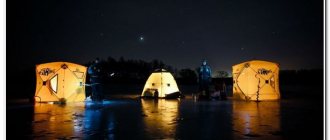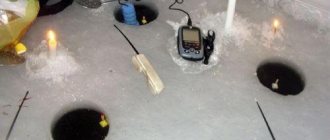When going fishing for bream on the first ice, you need to take into account the peculiarities of the process of formation of the ice cover. This directly determines whether this fish will be caught now or a little later. Unlike perch or roach, a good bite of bream does not always coincide with the beginning of freeze-up. In addition, during the fishing process you need to use certain correct search and feeding tactics. We will analyze all this in more detail in this article.
Bream on the first ice
At the beginning of freeze-up, the habits of bream depend on the speed of ice formation and the onset of winter. Usually, at the moment of the formation of the first ice and the next 7-10 days, it is difficult to catch bream. At this time, the fish adapts to new environmental conditions and hardly eats.
The entire cycle of the flock's daily rhythm is disrupted. Reflexively, after the formation of the first ice, the bream moves somewhat deeper, closer to its winter stopping places. Fishing during this period is difficult to predict.
If frost is pressing, and after freezing there is stable cold weather, winter comes into its own and the ice thickens, the bream usually moves to the deep edges, starting to feed in deeper water areas. In such seasons, usually after 5-6 days the bite gradually resumes, and you can begin targeted fishing.
If the reservoir freezes for a long time, the cold alternates with thaws, the first ice appears and then disappears - then a similar “chattering” can be traced in the behavior of the fish. Schools of bream, depending on the weather, either move deeper, then return to the middle watering areas. It is impossible to catch anything systematically. In some reservoirs during this period, bream may not bite at all.
Article about fishing on the first ice:
https://podlednik.ru/lovlya_zimoj/rybalka/po-pervomu-ldu
- In most cases, unlike catching perch or roach, the bream bite in the first ice does not begin immediately after the ice forms, but a little later, after a week or two, when the ice shell becomes stable and winter comes into its own. Therefore, catching this fish on the first ice occurs tactically in a slightly different way. There is no hunger for the first ice, like some other fish. The fisherman needs to wait for a stable bite a little later.
- By that time, schools of bream will already be in their winter quarters, in deep sections of the riverbed or holes next to the feeding tables. A certain system will develop in the fish's routine - feeding times, paths and routes to get to the feeding tables, some habits specific to a particular reservoir and elements of the daily life cycle.
- The small underbreeder usually begins to feed on the first ice immediately after the pond is covered with a shell. Unlike adult individuals, breams move more actively along the shore, as well as from the depths to the shallows and back. All this happens at depths somewhat shallower than those of adult bream. The most feeding deep-sea areas are immediately occupied by larger fish, while the bream settles down for a long time, gradually.
- You can catch a bream in the first ice both at depth and in shallower roach areas, at 3-5 meters. Therefore, in the first ice it is easier to catch a bream, rather than an adult bream, whose bite stabilizes a little later. Sometimes you have to run after a flock that actively walks throughout the day along the watering path, as well as from the depths to the shallows and back.
- In some seasons, during such fermentations, both large bream and white bream actively feed, and they can be caught using the usual search method using a jig at relatively shallow depths.
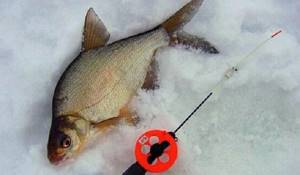
Fishing tactics
If the angler does not know in advance a place that is known to catch, then fishing should start with a search. After finding interesting disturbances in the relief, holes are drilled and baited. Usually the bream comes for bait within half an hour. After drilling and feeding, silence is maintained and the approach of the bream is expected. The main task of the fisherman is to identify holes in which he can linger. In case of bites, the fisherman once again feeds such points and fishes stationary, periodically throwing in a little bait.
Zone fishing involves feeding in several areas and then checking. The peculiarity of winter bream fishing is that even in familiar reservoirs you often have to look for fish, since the school periodically changes feeding places. Bream fishing tactics are always a kind of hybrid of walking and stationary fishing. Depending on the body of water, it can be completely different. The largest bream in many reservoirs is caught at night, so experienced bream fishermen hunt this fish at this time of day.
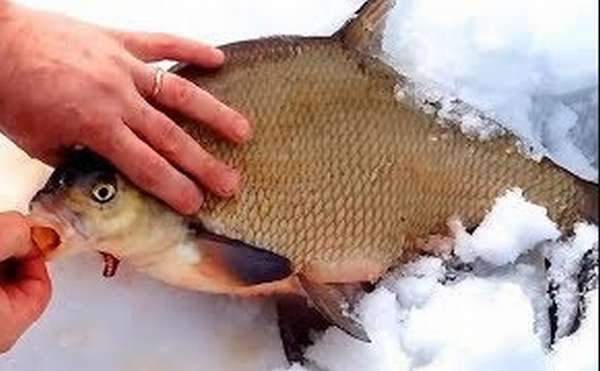
Night fishing in a tent
Night fishing for bream in winter requires the angler to have a tent. Light and heating in the simplest form - ordinary candles. If you are not familiar with the reservoir, you should arrive during the day in order to examine the terrain and search for places where you managed to catch at least a bream. And already there, set up a tent, feed and wait for the night bites. Night winter fishing has its own specificity and romance. You need to prepare for such fishing seriously, carefully consider the issues of equipment and nutrition, so that a pleasant hobby does not turn into a boring wait for the morning. Tackle, groundbait and bait are standard, as for daytime fishing.
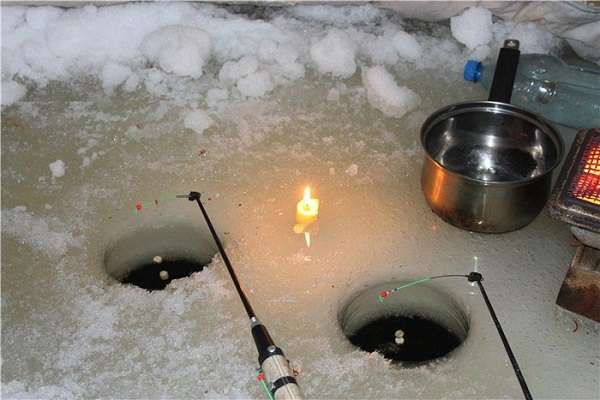
Where to look for bream on the first ice
Thus, bream fishing on the first ice can be divided into two periods.
- Adaptation period - the bite is unpredictable or non-existent. There are no bream in the winter holes and riverbeds yet, or they are not feeding. However, sometimes in some reservoirs, depending on the speed of winter, you can catch it in unobvious places by accident, both at medium and great depths.
- Stabilization of the bite - the bream has taken its winter resting places, the daily feeding cycles have adjusted. You can start targeted fishing. The cool spots found will generally work all winter with the right approach, unless the fish are driven away by a massive influx of anglers or a dramatic change in the environment (in regulated cascades of reservoirs).
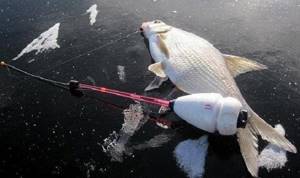
The standard task of an angler is to find bream sites for fishing during daylight hours or trails and feeding points where the school goes in search of food for fishing at night. Depending on the conditions of the reservoir and the weather, this scheme may change.
In addition, each body of water has its own characteristics that affect the behavior of fish. In some places, bream can come out to feed during the day. Just at the beginning of winter and on the first ice this happens more often. However, the standard behavior is still standing in a hole during the day and going out to shallow water for watering at night. Read more about the daily cycle of this fish and its life activity in a separate article:
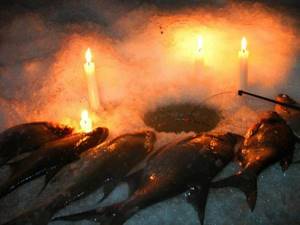
It’s easier with a bream – the range of places where it can be found is wider, and you can find a feeding flock both in the pit and on adjacent tables at any time of the day
Typically, hunting for bream on an unfamiliar body of water means catching bream while searching for trails and sites for smaller adult fish. You can catch white bream as soon as you manage to get to the areas of the reservoir adjacent to the riverbed and the outlets of the bays, even if the middle is not yet frozen.
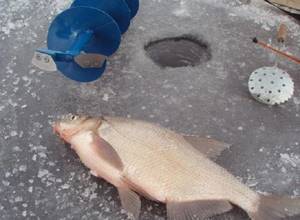
Rivers
Fishing for bream on the first ice on rivers becomes possible when the zone with depths of 5 meters or more, adjacent to the riverbed and pits, freezes and becomes accessible to the public. This happens later in rivers, especially when there is a current. However, by this moment the bream bite usually has already stabilized. At the beginning of freezing, when there is strong ice only in the coastal zone and in quiet bays, you can hunt in these places for roach, crucian carp or perch.
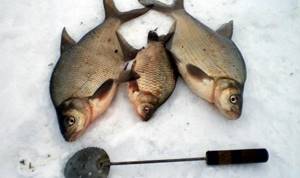
Promising places on the rivers:
- Deep-sea edges and tables along the riverbed, pits. If on one side the relief of the zone approaching the riverbed is flat, and on the other there are anomalies, holes and edges, then you need to look for bream precisely on the uneven surfaces.
- Changes in depth along the riverbed, underwater cliffs.
- Individual snags or large snags adjacent to the riverbed.
- Placers of stones or boulders at the bottom.
- Deep-sea colonies of zebra mussels and other shells.
- Input and output of the local pit.
- Channel bends, irregularities, underwater spits and gullies.
- Promising places are sections of rivers where a deep channel comes close to the shore. You need to look for bream in such places on the dump, but on the second side, farthest from the shore.
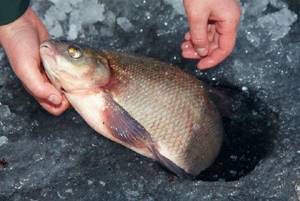
Reservoirs
Most reservoirs are once flooded rivers. Therefore, all the river places described above are also relevant for these reservoirs. The main search area for bream is a certain level of depth on the slope into the riverbed with a uniform topography, the edges themselves – with a stepped topography.
- Some reservoirs do not have anomalies that are particularly different from the main relief. A thorough search and sounding of the depths is important here. On a relatively flat bottom, it is important to find a drop into the riverbed that is sharper than elsewhere. Local holes or turns of the riverbed ditch are also promising - food is retained in such places.
- You can find bream in the reservoir based on knowledge of the roach habitat. If the roach’s roosting sites are known, then we look for bream one level deeper – on the next level edges and tables.
- On large reservoirs, navels and spits among great depths are promising. For example, among a depth of 10 meters there is a fairly large area of 7-8 meters, and even with shells or algae. Most likely, the bream is standing somewhere in a hole, and it comes out to eat at such a navel.
- We also examine the entire perimeter of such an elevation at its base, precisely at depth, especially if there are sharp cliffs, steps and slopes - the bream most likely stands in these secluded corners and holes.
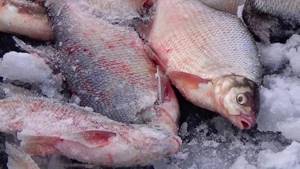
Features of behavior and life activity
In winter, bream feeds all winter, only the intensity of feeding changes, depending on the weather and environmental conditions. Difficulties in finding bream in winter begin with those fishermen who use tactics usually used when fishing for bream, roach, and crucian carp - as the most common under-ice trophies. Bream in the reservoir occupies a different niche. Against this background, fishermen sometimes make typical mistakes:
- They come to an unfamiliar body of water, without preliminary search or study of the bottom topography, they drill in one place, feed the hole and wait for a bite. This fishing tactic will pay off only if you are “lucky” to get to the spot right away.
- They purposefully find the deepest place and fish there.
- Attempts to “hatch” large winter bream in shallow water when fishing for bream and roach in the dead of winter.
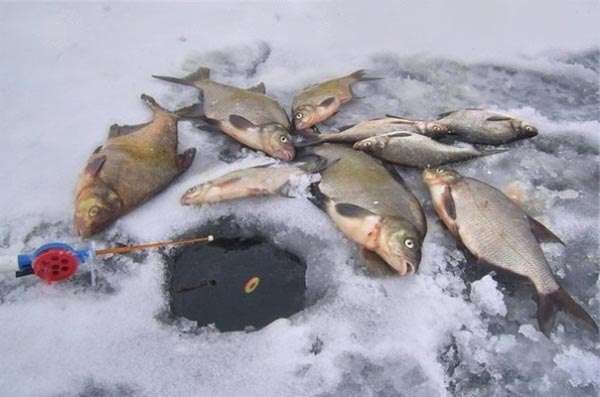
Pack lifestyle
The bream spends its entire life in a school. Small undergrowth (laskiri) form loose groups without hierarchy and live in coastal areas and thickets along with roaches, crucian carp and other “small things”. After two to three years, individuals that survive this stage acquire the habits of adult relatives. These flocks are denser, small in number (up to several hundred animals), and live in areas with medium depth. Such a group no longer feeds chaotically along the coastline, but makes raids on the most promising points for itself.
The large bream already leads an adult lifestyle. The pharyngeal teeth are already able to grind small bivalve shells of mollusks and snails, the flocks are not so numerous, there is a hierarchy in them - leader, core and scouts. Such a group lives at great depths, in the same place as large individuals. It cannot be said that bream lives sedentary. Yes, the flock lives in a certain water area, a food zone, but does not stand still, but constantly makes raids on promising points. And the fisherman’s task is to find such places. While moving, the fish almost does not feed, only the scouts (the smallest individuals in the school) scurry around the moving cannonball and taste what they come across.
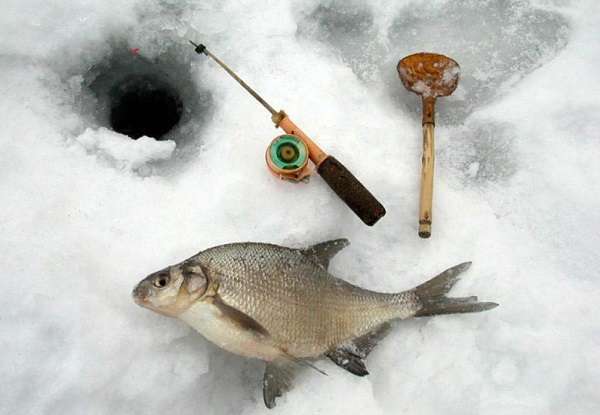
Adults
Large bronze beauties from 2-3 kg to 5 (and more) live in permanent flocks. They have a leader - the largest and oldest individual. The leader leads the rest of the group to the hot spots that he has known for many years. The rest of the bream repeat after him - if the leader feeds, then the whole flock eats. If the alpha runs away, then the pack will rush after him. Such groups number from 5-7 individuals to several dozen (even hundreds, in large reservoirs and lakes). Therefore, a fishing lure in the form of a bait spot should appeal to the leader, since he decides whether to feed in this particular place or not. It is the main and most cautious leader who cannot be scared off during the fishing process, since the entire flock will follow him.
In water bodies with a large number of fishermen, this works partially, since there are many transitional schools in them - those in which there is no new leader yet, and the old one, for example, has fallen for the fisherman's bait. There is no hierarchy in such groups. They either join others, or a new leader appears in them. The fisherman's task is to find the place where the fish visit for feeding, feed and wait.
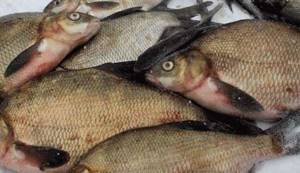
Eating Habits
The white bream consumes dozens of species of small crustaceans in its diet. The feeding preferences of adult fish are more constant - a school will not chase two crustaceans across the water area, it comes out day after day, year after year, to the same favorite places rich in food. These are uneven bottoms with rocks in which you can make money. Shell beds of zebra mussels or other small bivalves on slopes and tables among the prevailing deep depths are favorite places. This fish also likes to swarm in the recesses and under the edges in search of bloodworms, jigs (gammarus) and bristle worms.
Large bream dig holes in the feeding area to hard ground up to half a meter deep. Using the lateral line, they detect the micromovements of crustaceans and larvae in the depths of bottom sediments and dig the bottom, drawing masses through the mouth and gill covers and then throwing them back into the water. The larvae that enter the mouth at this time are distinguished by the fish using taste buds and swallowed. The bream seems to filter the bottom, swallowing food and spitting out inedible particles.
How to catch bream on the first ice
Fishing for bream on the first ice immediately after ice formation is an active search in areas with medium and deep depths adjacent to a riverbed or hole. At this time, if it bites, it is better to fish using the search method with an active jig or a reelless bait.
It is difficult to calculate any consistency in the bite and movements of bream at the very beginning of freeze-up. In most reservoirs during this period, this fish does not bite at all or is caught by accident.
After about 5-10 days, when the bite stabilizes, we use classic bream tactics. During the day we look for parking areas, at night we look for shallower areas adjacent to the depths, or we try to intercept the flock on the trails. It’s difficult to find a point in a large area of water; it’s much easier to get on the trail. The fisherman’s task in this case is to stop the moving school with attractive bait and force it to feed at this point.
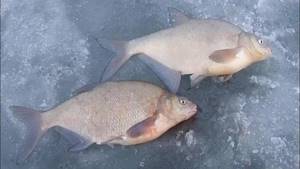
Search and catch tactics
The strategy and tactics of fishing for bream on the first ice after the fish have thoroughly established themselves in their winter habitats are not fundamentally different from the actions during the rest of the freeze-up period.
Each angler develops his own tactical model over time. To make it successful for bream, we take into account the following important points:
- Usually the winter stopping places and routes of bream do not change, so we search in well-known reservoirs and along the first ice in water areas where this fish is always caught in winter.
- The standard approach for bream is to fish during the day at depth, in the area where the fish are staying, and at night, in the morning or evening, on nearby tables, edges and watering areas, in areas where they feed. However, this does not work on all bodies of water.
- When targeting large bream, you need to avoid noisy crowds. However, a small group of fishermen acting quietly on the ice is not a problem.
- After a crowd of anglers has left well-fed places, it is sometimes useful to check these holes after a while. A large bream, which was previously afraid to do so because of the noise and activity of anglers on the ice, may approach them.
- In a promising water area, we drill all the holes in advance and feed them, so that later we do not frighten the bream that enters the square. We gradually fish the holes and check them in order to find the school. The goal is to intercept bream on the trail.
- Each person has their own pattern for drilling holes - in a snake along the shaft, radially around the central one, in a square-cluster method. The distance between reconnaissance holes is 10-15 meters. Near the working hole, if there are bites, you can drill more often, every 3-5 meters, in order to accurately find the working depth on the dump.
- Standard practice is to drill out an area that includes the beginning of the channel, the dump and the first table near it. It is not known in advance where the bite will be better. During daylight hours, the majority of holes are in the hole at its edge, with several on the approaches to it. When scouting before night fishing, on the contrary, we focus on feeding tables.
At points that consistently produce fish, you can immediately drill double holes - so as not to have problems later when landing large fish. Bream over 2 kg do not always fit even into a 200 mm hole.
Video about drilling double holes for bream:
Actions to take when biting weakens (stops)
When fishing for bream or bream, the extinction of the bite is common; this is a characteristic feature of winter bream fishing, which is associated with the behavior of the fish under the ice. Perhaps the fish are starting to get scared that their relatives are starting to take turns being removed from their native element. But most likely, everything is more banal - the flock, in principle, does not like to stand in one place for a long time. The fish walks along the route, visiting hot spots.
Ideally, the holes fed by the angler are the points that the flock will visit. After catching several fish, when there is a pause in the bite, it is better to feed the hole and leave it for a while. During this period, you can visit other points and check them out, and then return to the main hole.
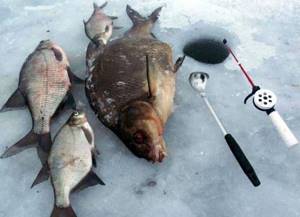
Sometimes the flock literally walks without stopping. In this case, you need to sort of proactively follow her. You need to overtake the bream along the vector of its movement, have time to drill a hole and feed it. Such running often occurs on reservoirs and large rivers for bream, blue bream, and silver bream. However, this also happens with bream.
The bite may disappear, since it is on this reservoir that the bream feeds at strictly defined hours, and now it’s simply time for a pause. Also, in some places, bream react differently to certain baits at different times.
For example, in the morning I took a large jig with a bunch of bloodworms from the bottom, and in the afternoon - only a small one with one larva, or even a little devil or another mothless one. Therefore, it is useful to use various gear and methods while fishing until the most effective one is found. Exactly the same - after the biting stops. We check the fed holes with various tackles.
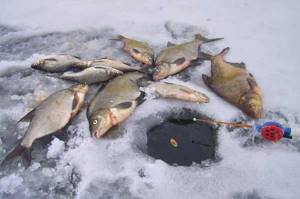
Night fishing
On most reservoirs, the best time to catch bream is at night. At night, you have the best chance of hooking a trophy bream. Even if the bite is not bad during the day, in most cases at night it is better. When preparing for bream fishing at night, it is still dark to find points, at least with large bream. Such holes are fed, preferably with live jigs or bloodworms.
The bream purposefully searches for places based on the micro-oscillations of these larvae, which it senses along the side line tens of meters away. A large bream will most likely enter a hole well fed with live larvae at night, even if this is not its usual feeding point. If you managed to find and feed on the bream feeding table on the first ice, you will be provided with a catch, if not in the evening, then in the morning.
At night you don’t really run around searching. Therefore, 3-4 points are fed in advance, between which the angler runs during fishing. Naturally, the tent is placed in the most promising place. It happens that catching bream on the first ice at night is also running after a flock that does not want to stop in one place for a long time. It is better not to drill again - this can scare away large fish for a long time. Therefore, we prepare and feed the holes in advance.
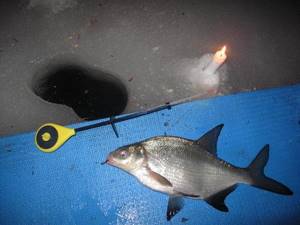
Baits and groundbait
The main bait for bream is a bunch of bloodworms, as well as a jig in those places where this crustacean forms the main food supply. In all cases, bait is desirable - live jig or bloodworm, lowered to the point by a dump truck. Burrowing around a point in the ground, these organisms attract bream with their movements.
For bream you need at least 1-2 kg of live bait - for reconnaissance holes and for supplementary feeding of the main bait during fishing. Not all fishermen have the opportunity to constantly use such bait. Therefore, amateurs in most cases use winter plant mixtures with the addition of live bloodworms. The more larvae you add, the better. But at least a little bit is a must.
Bream in places visited by fishermen gets used to bait and begins to constantly visit such places. However, large individuals will enter such points only at times of minimum number of anglers, during periods of calm on the ice.
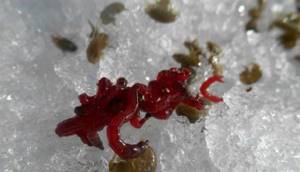
When fishing constantly in one place, the prey holes need to be remembered and fed - they can work stably all winter. On our next fishing trip, we check these secret spots first.
In some visited places, such holes wander from hand to hand, right up to a telephone call in advance - some left, the next sat down. Such places need to be protected and hidden, as they can easily be damaged, for example, by using the wrong bait, and drive away the fish.
Bream should not be overfed. Winter mixture is finely dispersed, special for ice fishing. The simplest option for making it yourself is breadcrumbs and ground fried seeds with the addition of a living component. Read more about the correct winter bait for bream:
https://podlednik.ru/nazhivki-i-podkormki/zimnyaya-prikormka-dlya-leshha
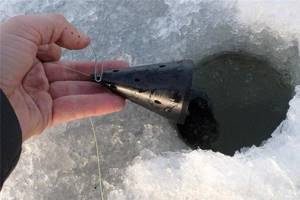
Search for fish sites
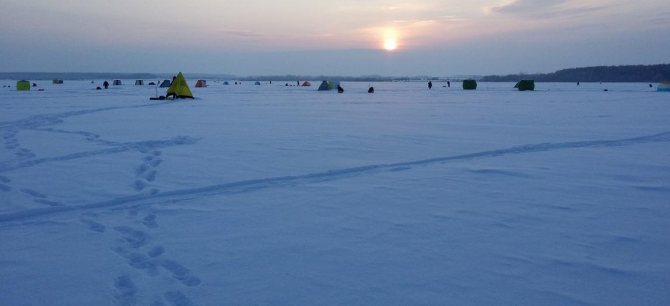
As you know, large bream choose large, deep reservoirs for wintering. This is due to the comfortable temperature and favorable oxygen regime. Therefore, if you want to catch a good “bast fish”, then you should not waste time on small rivers and ponds. Most often, they will contain bream, perhaps in sufficient quantities.
Catching large bream in small reservoirs in winter can be an exception to the rule. For example, the fish simply could not leave their summer places for some reason. This happens quite rarely; we will not consider these bodies of water. We will talk about large lakes and ponds, where the average depth is 4-6 meters or more.
Fishing in winter on a large reservoir may at first seem difficult to an inexperienced angler. When you go out into the wide open spaces, you involuntarily want to become attached to the fishing spot.
You should look for fish in places where the average depth borders on dumps or riverbeds. Winter fishing for bream often requires moving, so you won’t be able to get by with a couple of holes. The optimal number of them is 5-7 pieces, and the distance between them is better to be ten meters. The spread is needed in order to more reliably “tie” the bream to individual feeding points.
Recommended reading: Catching pike perch in a plumb line
To find bream sites, some anglers drill 2-3 dozen holes. Most likely, only a small part of them will be successful and they will be discovered during the fishing process. Such work is justified on an unfamiliar or unfamiliar body of water. Also, such preparation will not hurt if you are preparing for night bream fishing in a tent.
Tackle
What to use to catch bream on the first ice depends on the angler’s preferences and the presence of a current. The main feature is the fairly large depths. In calm water, it is better to use sensitively tuned float or nod fishing rods, as well as active play with a jig or reelless jig. In strong currents, heavier equipment is needed - sub-ice bottoms, weight fishing rods that can hold the equipment in place in the flow and tackle on ice.
Winter float rod for bream
The float rig should be adjusted precisely to the weight of the jig or sinker, so that the bream does not feel the weight of the load when it takes the bait into its mouth. Otherwise, he will simply automatically spit out the inedible particle. At great depths, even in a reservoir, there is always a minimal current, and light equipment with one small float can be pulled under the ice.
For bream, it is better to use larger joints or equipment with two floats loaded with several pellets of different diameters. More information about rigging winter fishing rods for bream:
https://podlednik.ru/lovlya_zimoj/na-udochku/zimnie-snasti-na-leshha
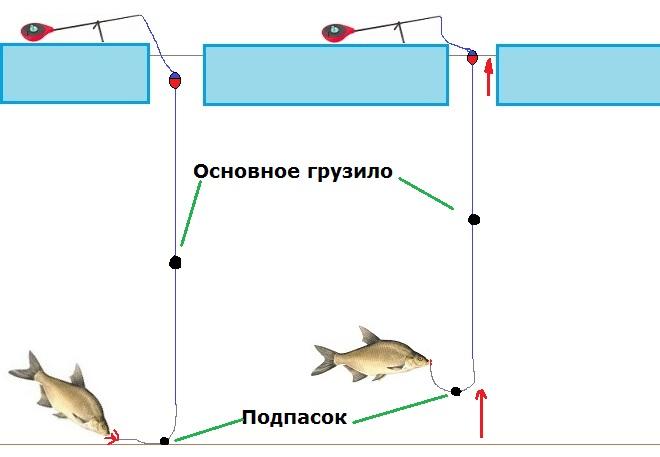
Nodding winter fishing rod for bream
Some anglers prefer to use nods. This is especially justified in reservoirs where bream take better either on a stand or on a playing jig. Then you can fish with the same gear using these two methods. When setting up, it is also important to take into account the tendency of bream to spit out the jig. It is better to use a long nod for bream, with a large amplitude of work.
Due to the peculiarities of the body constitution, the bream lifts the bait quite high when it takes it into its mouth. All this time, the nod should make an upward extension movement, taking over and compensating for the weight of the bait.
The longest arm of work can be achieved using special guards - a balancer on a bearing, a crossbow nod and the like. However, such designs have other disadvantages, so most anglers use conventional lavsan or metal long nods.
The equipment of the working part is standard, a jig or a hook at the end of the fishing line. You can attach pendants to the base using a lead leash or in tandem with a steam locomotive - sometimes bream take better on a pendant.
More information about making a crossbow nod:
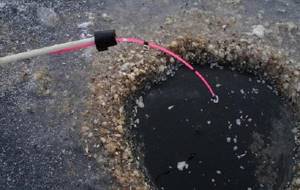
Current rigs
On the current you need heavy gear - dock trucks, descenders (harvesters), a helicopter. The equipment of such fishing rods is built on a similar principle. A heavy sinker or feeder is attached to the end of the fishing line, and hooks and jigs are attached to the outlet leash. For large bream, the main fishing gear on rivers with a current is the launcher. On descenders and combines, a long tail with hooks is launched quite far from the hole downstream.
Large bream sometimes do not come close to the hole, staying lower at a distance of about 10 meters. The long tail of the trigger just penetrates this range. Instead of a sinker, a feeder is installed on such tackle, into which bloodworms, bait or jigs are stuffed. Article about catching bream using a combine from ice
Attachment jig
An attached jig also works on bream. More often it is used when catching bream, which flies onto the hook along with roach or perch. Catching bream on the first ice with a jig is no less popular than hunting for perch or roach during this period. Sometimes even large bream attack the game, and not the standing bait.
The game for bream requires a special one - smooth and slow. The fishing rod for bream is equipped with long nods, 18 cm or more. And so jig tackle for bream is built according to the rules of bait fishing. The fishing line, guard and nod are selected depending on the caliber of the tackle. Detailed article about catching bream with a jig, setting up the tackle and playing correctly:
https://podlednik.ru/lovlya_zimoj/na-mormyshku/mormyshki-na-leshha-zimoj
Mothless
In the baitless version, devils are more often used for bream. Among the fishermen, there is even a separate caste of “devils” who constantly practice fishing with this bait. The basis of the wiring is the monotonous and smooth movements of a tandem devil located on a line by a steam locomotive.
Just on the first ice, bream fishing with the devil shows the best results. Fishing takes place at great depths, and it is easier to control devils at such a distance than light jigs.
If you use small pot-bellied baits for roach, then long, black ones for bream. Color rendition at depths greater than 5 meters is minimal, so there is no point in bothering with colors. Bream reacts primarily to correct vibrations and play. Centimeter-long devils in tandem at great depths normally pull the fishing line into a line up to 0.16 mm. Article about catching bream with a devil:
https://podlednik.ru/lovlya_zimoj/na-mormyshku/leshh-zimoj-na-cherta
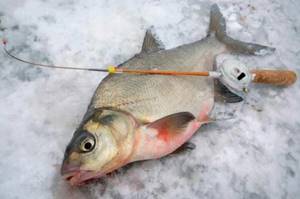
Lure
After preparing the holes, they need to be fed. A purchased mixture or food bloodworm is suitable for this; the main thing is not to overfeed the fish. Use 50g of feed per hole. It is better to use special mixtures for cold water.
A good option would be bait prepared at home. The composition may include various cereals, peas, etc. in a word, what fish love even in the summer.
It must be remembered that bloodworms can attract predatory fish or roaches, which will not allow the bream to approach the point.
For the whole day, 1.5 kg of feed will be enough. A special feeder is used to feed the holes.
Safety measures when being on the first ice
The first ice is a dangerous time. Not everywhere you can walk on ice without fear. To catch bream, you need to go out to the fairway and the adjacent waterways, and in these places the ice freezes later, especially on rivers and flowing reservoirs. Therefore, it is better to go fishing together, tied with a rope and moving at a distance of at least 10 meters. We take rescue gear and an ice pick with us, which we use to tap each step. If the ice breaks through with the first blow, we don’t go any further, it’s dangerous. Read more about safety when fishing from ice
Subscribe to the channel:
My YouTube channel RYBAFAN on fishing:
We're OK
What to feed
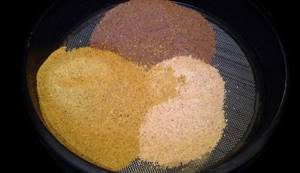
There have been, are and will be a lot of opinions and discussions about bait. It’s not for nothing that they say how many people have so many opinions. Some fishermen argue that winter bait should contain a minimum of aromas. Others (there are fewer of them), on the contrary, believe that odors in cold water should be more powerful. The amount of food should not be too large, otherwise there is a risk of simply overfeeding the bream.
When the depth exceeds four meters, a feeder will help deliver complementary food. If there is 2-4 meters under the ice, you can simply lower the diluted bait into the hole. An exception may be when catching bream in the winter on the current, if the current is noticeable, complementary food is served only with a feeder.
We recommend reading: Crucian carp killer tackle
Some fishermen purposefully add small, feeding bloodworms to the bait. How this affects the fish’s appetite is again anyone’s guess. On certain days it can really help, and sometimes it can actually hurt.
My personal opinion is that groundbait is not so much food as it is an appetite enhancer. A kind of spice that, when added, would make you want to eat more. After all, smells affect a person’s appetite, so why shouldn’t they also affect fish? But the composition of winter food should not be made nutritious, after all, this is not summer. It is believed that bream is partial to the smells of coriander, cinnamon, hemp, and sunflower seeds. You can experiment with them. It is especially good if fishing takes place frequently and in the same body of water.
Mormyshki in winter
White bream can be easily caught on the first ice not only with a reelless bait, but also with a jig with an attachment.
The most catchy ones
- Ant. The jig is most effective when retrieved slowly, simulating an insect that has fallen into the water;
- The pellet is a classic jig in the shape of a ball. Any fisherman's arsenal must contain this jig in different colors;
- Nymph is a droplet-shaped jig. It is clearly and vertically in the water, forming a small angle;
- Cobra is an exotic jig that has won honor and respect from many lovers of bream fishing. The shape of the bait resembles the head of a cobra. This type of jig is suitable for any biting intensity and varied gameplay;
- Uralka is an imitation of jig as a natural fish food. This is the discoverer of all jigs. The most effective wiring is combined.
Catching and playing techniques
We begin catching winter bream by studying the bottom topography using a camera or echo sounder . Having found interesting areas, we feed the places, throwing a large amount of complementary food into each hole, but without bloodworms. We wait half an hour and start fishing.
The technique of playing with a jig can be varied and is determined by the current behavior of the fish; you just need to adjust your game to the bite. Among the common techniques are tapping on the bottom, lightly moving when the jig is lying on the bottom , slowly raising the jig with frequent fluctuations to a height of 20-30 cm. Very often, the bream is caught on a jig calmly lying on the bottom or raised 1-2 cm from it.
Fishing for bream requires a leisurely withdrawal of fishing line. When the fish makes a jerk, the line needs to be lowered a little. When approaching a hole, if there is a large bream there, we use a hook.
Nod rig
- Fishing rod in the form of a balalaika;
- Not the shortest nod, consisting of elastic material;
- Choose the diameter of the fishing line in the range of 0.1-0.12 mm;
- Jig or hook with sinkers.
